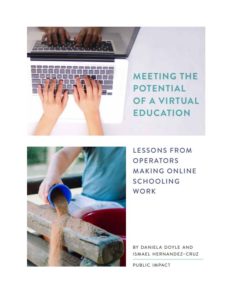In general, virtual charter schools have had poor outcomes. A 2015 study from CREDO (the Center for Research on Education Outcomes) found that, on average, students enrolled in online charter schools lost 180 days of learning in math and 72 days of learning in reading compared to similar students in brick-and-mortar schools.
But virtual schools have the potential to give students access to high-quality instruction regardless of time and place, and to allow students to speed up or slow down based on their interests and needs. And when we scanned the field for virtual charter schools with positive learning results, we found a few. What can others learn from them to make virtual school success the rule, not the exception?
In Meeting the Potential of a Virtual Education: Lessons from Operators Making Online Schooling Work, Public Impact’s Daniela Doyle and Ismael Hernandez-Cruz highlight the experience of two nonselective virtual charter schools making online schooling work for their students—Idaho Distance Education Academy (I-DEA) and New Hampshire’s Virtual Learning Academy Charter School (VLACS). While neither school is an exact demographic mirror of traditional public schools in their states (discussed in the report), both outperform their states in reading and math proficiency, among other positive outcomes. (For more on how these schools were selected to highlight, see What Is Virtual School “Success”? in the report.)
Doyle and Hernandez-Cruz identified four lessons and four recommendations for virtual charter schools.
Lessons:
- Strong teaching (still) drives student success—Just as in traditional schools, teacher selection is crucial. No computer program, no matter how great, can replace an excellent teacher.
- Personal connections are key—“We can’t do anything else that we’re doing without that foundational connection,” Jason Bransford of I-DEA said of efforts to form relationships with each student’s entire family. Likewise, VLACS ensures connections to students and families through a deliberate and intensive system of advisors.
- Student learning must be the center of school design—Both schools have incorporated elements of personalized learning by designing their programs around what students need to succeed, with VLACS in particular creating a very flexible, personalized experience.
- Schools set high expectations for students and families—Both make clear from the moment of enrollment that they do not offer an easier education than traditional schools, setting and communicating high expectations even if doing so leads some families to go elsewhere.
Recommendations:
- Be sure to incorporate the same elements that drive student success in brick-and-mortar schools—in many instances, great schools are great for the same reasons, regardless of setting.
- Identify and adjust to what is truly different about online schooling—for example, focus on elements such as effective online engagement and communication, and support and develop teachers in those areas.
- Use the unique opportunities online schooling offers—take advantage of the opportunity to truly meet students’ individual needs.
- Innovate, don’t just automate—focus on using technology in new ways that better meet the needs of all students.
The field needs more research to broaden and deepen its understanding of online schools’ success. For these two schools, a deeper analysis of how different student groups fare over time relative to their peers might shed more light on their successes and challenges. Finding and studying other online schools achieving promising results would also provide more insight. Meanwhile, these two schools illustrate practices that others can put into action for their students.
About VLACS
- Open since 2008, VLACS serves nearly 400 full-time middle and high school students and more than 13,000 part-time students from New Hampshire, plus about 100 tuition-paying out-of-state students.
- Students can enroll at any time.
- Rather than earning credits, they focus on mastering competencies.
- Students choose from learning “journeys,” including courses, projects, career badges, experiences, teams, and an early-college option.
- Students work with advisors to set an appropriate learning pace to master competencies and can accelerate or slow down as needed.
About I-DEA
- Open since 2004, I-DEA now enrolls about 700 full-time students in grades K–12.
I-DEA tends to enroll lower rates of students of color than the state overall but enrolls a similar rate of low-income students. - I-DEA offers considerable flexibility, but also requires students to participate in live online classes at set times twice a week.
- I-DEA follows a calendar, with classes starting and ending at set times during the year.
- I-DEA offers students access to college-level courses, and on average, 20 percent of students graduate from high school with a two-year college degree.

